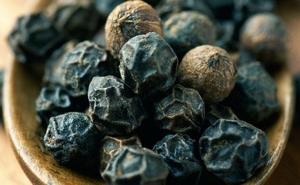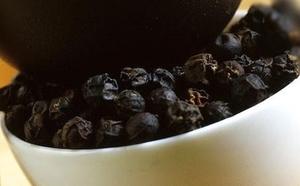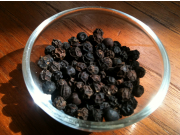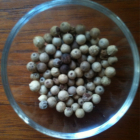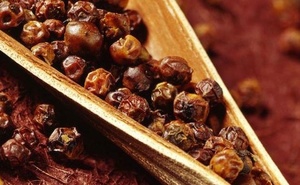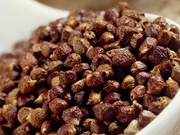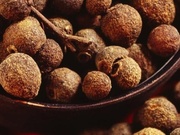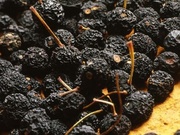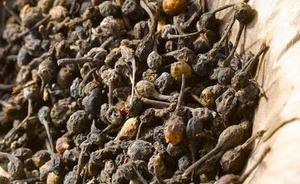Peppers of all types, one species
Black, white and green peppers are berries from the same tropical climbing vine, Piper negrum. Ripeness and processing method determine pepper color, flavor and aroma. Peppers originated in southeastern India, where the hot and humid climate is still ideal for pepper cultivation and is home to some 75 types of pepper. Similar to wine, peppers are named after their place of origin or port of shipment, as local soil, mineral content, sunlight and rainfall differentiate taste and fragrance.
Peppers provide both flavor and heat in many varieties, with subtle differences in aroma, taste, appearance and overall appeal. Peperine, the key volatile oil, combines with various resins to stimulate the taste buds, appetite and disgestion. In sufficent quantities, peppers actually have a cooling effect.
Kerala Telicherry black pepper - India
Among the highest quality, and largest, Indian black peppers. Full, complex flavor with a distinctive citrus aroma. Our strongest black pepper with 6.6% piperine content. Recommended for use in almost everything.
Lampung black pepper - Indonesia
From the small Indonesian region called Kota Bumi or "Center of the Earth," where farmers still use the traditional system of shade growth, which protects the vines from heat and harsh sunlight while enriching the soil with nitorgen-fixing legumes planted on the forest floor. As a result, the pepper berries are incredibly pungent with an almost chili pepper-like heat. Selected from less than 1% of the total harvest, the Lumpung pepper bold and pungent flavor is well-matched to red meats, roasted poultry, grilled vegetables, tomato sauces, marinades and dressings, soft cheese, chai tea, and syrups.
Ambolikapiky organic black pepper - Madagascar
From the Akesson family Ambolikapiky cocoa and spice plantation (est. 1920) in NW Madagascar, these specially selected pepper vines grow in the shadow trees protecting the cocoa plants. Extremely aromatic, with warm notes of pine kernel and fresh notes of green fruits, Madagascar black pepper complements the musk flavors of pork, envigorates beef, accentuates the taste of eggs and raises the delicacy of oil-rich fish preparations, such as marinated or smoked salmon.
Penja black pepper - Cameroon
Combination of volcanic soil and equatorial climate of Cameroon's Penja Valley produce a pepper that is soft and refined, with a very delicate perfume followed by a robust, spicy, flavorsome warmth. Only the largest berries are selected. Black Penja pepper complements the musk savours of pork and gives flavor to beef preparations.
Sarawak black pepper - Malaysia
High-quality Malaysian pepper with strong earthy-woody, dried herbs and roasted flavor, slightly spicy. A favorite among Japanese and other Asian connoisseurs. Heating over a longer period generates a slightly bitter taste, so rather used at the end of cooking.
Malabar white pepper - India
Very strong flavor and aroma of goat cheese and green herbs, for white meats.
Muntoc white pepper - Indonesia
Relative of the Lampung pepper, grown exclusively for making white pepper in the hills behind Muntoc village on Bangka island. Local farmers handpick spikes of red ripe pepper berries, packing them into rice sacks to soak in the slow running streams from the mountains above for seven days. After the outermost skin comes off, the peppercorns are piled together for a traditional trampling called "nari mereca" or Pepper Dance, which separates the peppercorns from the fruit spike. After a final washing the berries are left to sun dry, naturally bleaching to a whiteish-cream. Rich, winey flavor ideal for pork tenderloin, veal chops, poultry, white fish and shellfish, rice and pasta, steamed vegetables, blue cheese and pears.
Penja green pepper - Cameroon
A rare pepper with a mild flavor from the volcanic soil and equatorial climate of Cameroon. Fresh citrus fragrance and heat suitable for delicate meat or fish preparations.
Pondicherry red pepper - India
A sweet and spicy red pepper, exclusively produced for the house of Thiercelin. Carmellized, fruity, sweet-spicy flavor. For red and white meats, salads and fruit tortes.
Peppers that are not true peppers
Many so-called peppers are not true Piper negrum, but from different species with unique aroma, distinct appearance and exquisite flavor.
Examples include: Allspice, Cubeb, Long Pepper, Maniguette, Nepali Timut, Pink, Selim, Szechuan, Tasmanian, and Voatsiperifery peppers.
Long pepper - India
From the flowering vine Piper longum, was an important spice among the ancient Greeks until it was replaced by the black pepper. The flavor is deep and complex, with a floral bouquet, an earthy pungency and a sweet hint of cardamom and nutmeg. Stronger, sharper and hotter than black pepper, with numbing properties. Ideally pairs with lamb, pork loin, vegetable soups and purees, mashed potatoes, goat cheese, poached fruits, chocolate, pears, strawberries, cherries. Traditionally used in Indian pickles, North African spice blends, and Malaysian and Indonesian cuisine. Traditional Hindu aphrodisiac, stimulant and aid to digestion.
Cubeb pepper - Indonesia
Unripe fruit of the wild vine Piper cubeba, grown in Indonesia. Hot, camphorous, peppery flavor and pleasant warm fragrance a cross between black pepper and allspice. Pungent with slightly bitter taste. For fruit and ginger cakes, fresh fruit (e.g. pineapple, strawberry, and fig), and pickles and sauces. Often a component in Arab spice blends.
Grains of Paradise / Maniguette pepper - West Africa and Ethiopia
Aframomum melegueta belongs to the ginger family, found in West Africa and Ethiopia. Noted for its pungent peppery flavor, warmth, and ease in digestion; a healthy replacement for black pepper.
Pink pepper - Réunion
Berries from the sumac family, mainly produced on the isle of Réunion. Sweet, aromatic and mild, with none of the spicyness of pepper. Brittle shell.
Timur pepper from Nepal (टिमुर) - NEW
This rare pepper from the same family as Szechuan pepper is characterized by its citrus notes. Its fresh, rustic, lemony aroma recalls grapefruit. Pairs well with fish, shelfish, white meats and also with fruits (pineapple, mango, etc.) Exciting!
Allspice - Caribbean
From the dried unripe fruit of Pimenta dioica, an evergreen found in the Caribbean islands. Its light burning aroma reminded English traders of clove, nutmeg, cinnamon and black pepper, hence the name. Pungent, when blended accentuates some spices while suppressing others. Used in Caribbean and Levantine meat dishes, Indian chutneys and curries, European sausages, cakes, puddings and mulled wines, and North American chilis and BBQ sauces.
Szechuan pepper - China
From the dried fruits of Xanthoxylum piperitum, usually only the better quality outer shell, not the inner seed, is used. Pleasing, lemon-like woody aroma. Sharp bite, pungent, gradually produces a numbing feeling on the tongue.
Tasmanian - Australia
From the aborginal Australian Tasmannia lanceolata pepper. Wonderful floral aroma. Initial sweetness followed by a piquant bite and later a general numbing sensation. Best crushed with mortar and pestle, complements lamb, pork and game roasts and grills. Adopted by Italian and Asian cuisines.
Voatsiperifery wild pepper - Madagascar
One of most rare and extraordinary peppers, only 1500 kg of the wild Piper borbonense ("Tsiperifery" in Malagasy) harvested annually, hand-selected by villagers in the eastern Madagascar rainforest. Its refined earthy and woody taste is completed by citrus and floral aromas bringing freshness to the palate. Particularly long lasting, goes well with lamb, pork, fruits and chocolate.



